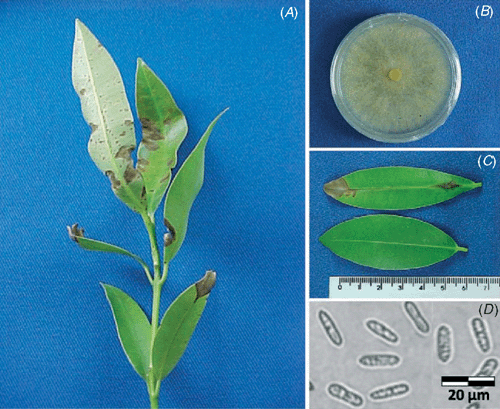First occurrence of anthracnose caused by Colletotrichum gloeosporioides in Callophylum brasiliensis in Brazil
D. D. Rosa A C , M. V. Masson A , C. T. Ohto A , M. A. Basseto A , R. V. B. Avellar B and E. L. Furtado A CA São Paulo State University, UNESP, College of Agronomic Science, FCA, Department of Plant Production, Plant-Health Protection Sector, PO Box 237, Botucatu, SP 18610-307, Brazil.
B Agropecuária Santa Helena Com. e Emp. Ltda, Projeto Matas Nativas, Estrada municipal Itatinga, Pardinho, km. 7, PO Box 3, Itatinga, SP 18690-000, Brazil.
C Corresponding author. Email: ddrosa@fca.unesp.br
Australasian Plant Disease Notes 3(1) 105-106 https://doi.org/10.1071/DN08042
Submitted: 12 May 2008 Accepted: 13 July 2008 Published: 23 July 2008
Abstract
Reddish-orange spots with chlorotic halos were detected in leaves of guanandi (Calophyllum brasiliensis) in Botucatu region, Brazil. Colletotrichum gloeosporioides was identified as the causal agent. This is the first report of Colletotrichum gloeosporioides causing anthracnose in Brazilian guanandi plants.
Commonly known as guanandi or jacareuba, Calophyllum brasiliensis is an arboreal species in the Clusiaceae family. It is found in wet forests from the north of Santa Catarina State, in Brazil, to the Amazonian region in South America. This species may reach up to 40 m in height and produces excellent quality wood for furniture manufacturing (Toniato et al. 1998). Currently, guanandi is commercially grown in the Brazilian south-east and central-west regions, covering 50 000 ha.
In Brazil, some guanandi plants, located in the São Paulo State, have been observed to be exhibiting leaf spot symptoms. This was being controlled with the application of fungicides, but the causal agent was not known. Control of this disease was increasing the cost of deployment by more than 4.2% and plant growth was reduced.
In December 2007, 8-month-old guanandi plants obtained from a commercially reforested area in central-western São Paulo State, in Brazil, first presented reddish-orange spots with chlorotic halos in their leaves (Fig. 1A). Plants were harvested and sent to the Phytopathological Clinic, Department of Plant Production, Plant-Health Protection Sector, Agronomical Sciences College, São Paulo State University, UNESP, Botucatu, São Paulo, Brazil, for analysis.

|
Next to the spot regions, salmon-coloured spore masses and subepidermal acervuli with setae and conidiophores, short, erect and simple were detected. Tissues adjacent to spots were sampled and surface-sterilised by washing in 70% ethanol for 30 s, followed by 1% sodium hypochlorite for 60 s and then sterile distilled water. These samples were plated onto Petri dishes containing potato dextrose agar (PDA) culture medium and incubated at 25°C in the dark for 3 to 10 days.
Colonies obtained from tissues had abundant growth, whitish colouration (Fig. 1B) and abundant sporulation, the colour of which varied between salmon and orange in the culture medium. Conidia were hyaline, oblong, unicellular and had round extremities. Their mean length was 15.2 μm, varying from 13.9 μm to 16.7 μm, and mean width was 5.2 μm, varying from 4.8 μm to 6.2 μm (Fig. 1D). According to morphological and cultural characteristics (Sutton 1980, 1992), Colletotrichum gloeosporioides was the organism isolated in the PDA medium. As a typical feature of C. gloeosporioides, a complete growth inhibition of the isolate was verified in PDA medium amended with 1 µg/mL benomyl (Peres et al. 2004). The isolate was stored in the Mycological Bank of São Paulo State University and identified as MDF0023.
Koch’s Postulates were followed to verify the pathogenicity of the isolate. Here, 6-month-old guanandi seedlings were kept in a greenhouse, at 24 ± 3°C, in 2 L pots containing an organic substrate. An aqueous spore suspension (2.7 × 105 spores/mL) was prepared from a culture of the C. gloeosporioides isolate grown in PDA for 7 days at 25°C in the dark. The spore suspension was sprayed to the point of runoff on the leaves of 10 plants. In the control, 10 plants were sprayed with autoclaved distilled water. All plants were then maintained in a wet humidity chamber at 24 ± 3°C for 24 h and then the plants were kept in greenhouse at the same temperature. Fifteen days after spraying, the previously described symptoms were observed in plants treated with the spore suspension (Fig. 1C), but not in the control plants. Subsequently, C. gloeosporioides was reisolated from tissues of the treated leaves and the pure culture reobtained, thereby ratifying the disease aetiology.
Colletotrichum gloeosporioides is a cosmopolitan pathogen and has been considered the causal agent of anthracnose diseases in at least 250 different botanical species. Currently, there are few studies on anthracnose in species within the Clusiaceae, and this is the first report of C. gloeosporioides causing disease in Calophyllum brasiliensis in Brazil and worldwide.
Peres NAR,
Souza NL,
Peever TL, Timmer LW
(2004) Benomyl sensitivity of isolates of Colletotrichum acutatum and C. gloeosporioides from citrus. Plant Disease 88, 125–130.
| Crossref | GoogleScholarGoogle Scholar |

Toniato MTZ,
Leitao-Filho HF, Rodrigues RR
(1998) Fitossociologia de um remanescente de Floresta higrófila (Mata de brejo) em Campinas, SP. Revista Brasileira de Botânica 21, 197–210.



